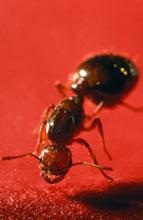A native of South America, this aggressive invader established the first Fire Ant Town around Mobile, Ala., in the early 1900s.
Rumor has it that the little buggers were stowaways on steamers. Apparently they found American soil so friable (and American flesh so tender) that they have engaged in a relentless northern march, traveling first throughout the southeast and now up both the Eastern and Western seaboards.
Fire ants sport a chillingly descriptive Greek name – Solenopsis invecta, "Unvanquished Channel-Faced." I leave it to you to decide if the imported red fire ant is "channel-faced," but I defy you to deny that it is unvanquished.
Fire ants are a species of the Hymenoptera, the insect order that includes wasps and bees, and they share some basic characteristics.
Unlike their cousins, fire ants are only winged during the spring, when they await Eros' call to fly from their nests in a mating frenzy – after which their diaphanous wings drop away and they build ever-more-complicated colonies that can spread throughout entire fields.
They also adhere to their order's inclination to live in large, hierarchical societies arranged around a queen, with armies of workers bent on aggressive nest defense — much to the dismay of bumbling human feet.
If you invade their space, the ants swarm out with a double-ended defense, Dr. Rapini, chair of dermatology at the University of Texas Medical School, Houston, said in a video interview.
"Unlike most ants, which just bite you, these guys bite with their huge jaws and then pivot around and sting you," with a venom filled dagger.
The resulting wounds are painful, itchy, and full of pus. Although familiar to Southern physicians who have seen the problem for years, Northerners are just coming to grips with these tiny purveyors of pustular pain.
"Sometimes doctors will even get a biopsy on this because they've never seen it before," Dr. Rapini said.
Because a fire ant bite/sting feels like getting burnt with a lit cigarette, most humans are cognizant enough to run hysterically away from a fire ant encounter, doing the "fire ant dance" to shake the critters off their legs and shoes and out of their trousers. But like drinking and driving, drinking and fire ant hills are not a good mix, Dr. Rapini said.
"My worst case was a guy who got drunk and passed out on a fire ant hill and came in with hundreds of stings," he said. The patient wound up in the hospital, desperately ill with a bacterial superinfection; treating him required both antibiotics and high-potency corticosteroids.
There have even been reports of fire-ant deaths.
For most folks, though, the bites are painful, but few. A prescription-strength corticosteroid cream will at least help get patients through the worst stages. "It basically is a self-limiting issue; the bites just go away over a week or two," Dr. Rapini said. "You really have to try not to scratch, though. That'll make a scab. And pickers get scars."
And by the way, humans aren't the only creatures to suffer at the jaws and stingers of fire ants. They can cause terrible injuries in reclining baby animals.
As are, apparently, cute little caterpillars and tweeting birdies.
— By Michele G. Sullivan (on Twitter @MGSullivan)



